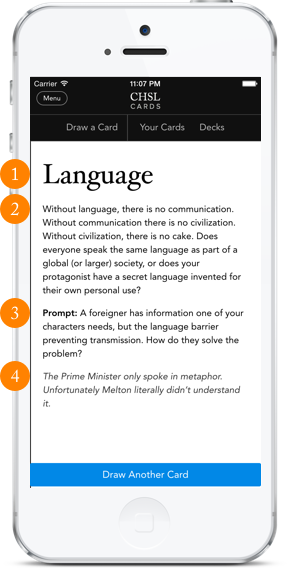David has already talked at length about the different ways you can use CHSL Cards to help shape your story: either molding it from the beginning or helping you with a quick and dirty prompt to get out of a tight spot. Today, I wanted to focus a bit on the design process of the cards themselves, what we wanted to accomplish, and how we set out to do it.
We knew early on in the process that we wanted CHSL Cards to be as versatile as possible, while still focusing on writing rather than other creative disciplines. We also wanted something clean and structured. It can be easy enough to get distracted while trying to write; our goal was to get users back into the flow of getting words on the page as quickly as possible. We wanted people to have the freedom to use CHSL Cards whenever they needed them, but also to spend the least amount time necessary with them, so they can get back to the business of writing their masterpiece. So, our design goals:
- Versatile
- Writing-Centric
- Simple
- Easy to Use
Early on, we settled on the idea of each card as just a single word. As early design is prone to do, we also toyed with a wide spread of different ideas. Some early versions had a few paragraphs of text. Others had distinct prompts, one each for Character, Setting and Plot.
Up until the middle of the project, we had envisioned CHSL as being both a digital and physical product—you could use the app, or buy a deck of actual cards that you could manipulate however you wanted. We thought about doing square cards, and being able to rotate them or drop them on a mat in some way to create some sort of story-telling game as an added bonus for you and your friends. We loved the idea of card art.
In the end though, we decided that these ideas, while fun, ultimately detracted from the simplicity that we craved with CHSL Cards. A physical deck was scrapped. Intricate card art was abandoned in favor of a more minimalist style. And we eventually decided on a blending of elements from previous iterations. So, here are the blocks of a CHSL Card:

- Card Name This is what the card is all about. Each card intentionally has a one word title, in case you want to use them to to simply free-associate until you come up with an idea on your own.
- Exploration Here the CHSL Card gives you a brief explanation of how you might use this to enhance, shape or craft different elements of your story. Where appropriate it highlights some different meanings and scenarios. Use this section if you just need a gentle nudge, or something to get your brain going.
- Prompt Here we give you a direct prompt to jump your story into action. These can range from having something happen to a specific character to world-building exercises, and everything in between.
- Flavor Text This was a late addition to the project. We were searching for one more way to direct the writing process, and were looking for something a bit different. So we thought, why not do some actual writing? These are random (often-times silly) quotations or bits of fluff from what could be actual stories. Sometimes they relate to each other, sometimes not.
We hope you enjoyed this inside look at how CHSL Cards were made Check out our next post in the series, where explore the process of actually creating the content for the cards and how we refined some of the concepts.